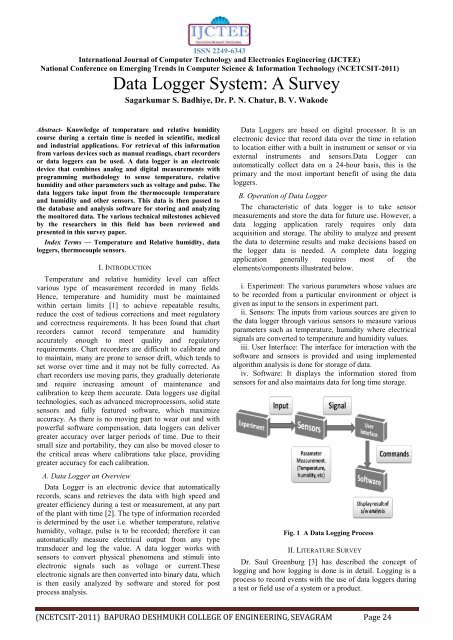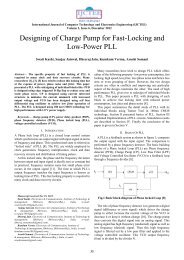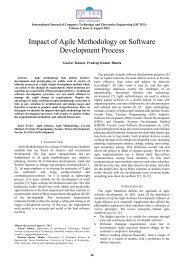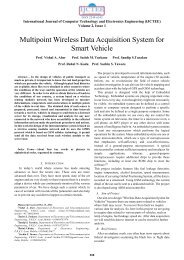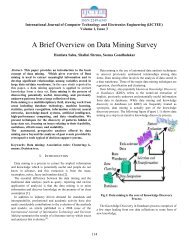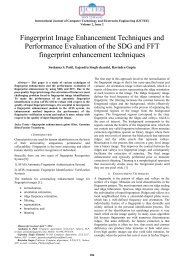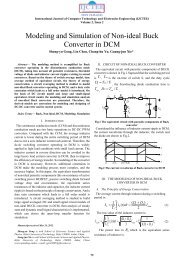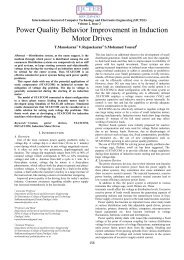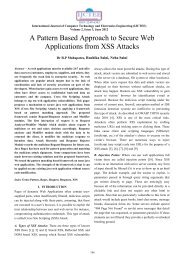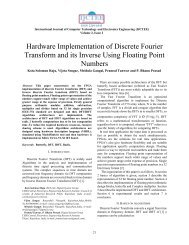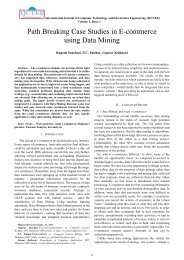Data Logger System: A Survey - International Journal of Computer ...
Data Logger System: A Survey - International Journal of Computer ...
Data Logger System: A Survey - International Journal of Computer ...
Create successful ePaper yourself
Turn your PDF publications into a flip-book with our unique Google optimized e-Paper software.
ISSN 2249-6343<strong>International</strong> <strong>Journal</strong> <strong>of</strong> <strong>Computer</strong> Technology and Electronics Engineering (IJCTEE)National Conference on Emerging Trends in <strong>Computer</strong> Science & Information Technology (NCETCSIT-2011)<strong>Data</strong> <strong>Logger</strong> <strong>System</strong>: A <strong>Survey</strong>Sagarkumar S. Badhiye, Dr. P. N. Chatur, B. V. WakodeAbstract- Knowledge <strong>of</strong> temperature and relative humiditycourse during a certain time is needed in scientific, medicaland industrial applications. For retrieval <strong>of</strong> this informationfrom various devices such as manual readings, chart recordersor data loggers can be used. A data logger is an electronicdevice that combines analog and digital measurements withprogramming methodology to sense temperature, relativehumidity and other parameters such as voltage and pulse. Thedata loggers take input from the thermocouple temperatureand humidity and other sensors. This data is then passed tothe database and analysis s<strong>of</strong>tware for storing and analyzingthe monitored data. The various technical milestones achievedby the researchers in this field has been reviewed andpresented in this survey paper.Index Terms — Temperature and Relative humidity, dataloggers, thermocouple sensors.I. INTRODUCTIONTemperature and relative humidity level can affectvarious type <strong>of</strong> measurement recorded in many fields.Hence, temperature and humidity must be maintainedwithin certain limits [1] to achieve repeatable results,reduce the cost <strong>of</strong> tedious corrections and meet regulatoryand correctness requirements. It has been found that chartrecorders cannot record temperature and humidityaccurately enough to meet quality and regulatoryrequirements. Chart recorders are difficult to calibrate andto maintain, many are prone to sensor drift, which tends toset worse over time and it may not be fully corrected. Aschart recorders use moving parts, they gradually deteriorateand require increasing amount <strong>of</strong> maintenance andcalibration to keep them accurate. <strong>Data</strong> loggers use digitaltechnologies, such as advanced microprocessors, solid statesensors and fully featured s<strong>of</strong>tware, which maximizeaccuracy. As there is no moving part to wear out and withpowerful s<strong>of</strong>tware compensation, data loggers can delivergreater accuracy over larger periods <strong>of</strong> time. Due to theirsmall size and portability, they can also be moved closer tothe critical areas where calibrations take place, providinggreater accuracy for each calibration.A. <strong>Data</strong> <strong>Logger</strong> an Overview<strong>Data</strong> <strong>Logger</strong> is an electronic device that automaticallyrecords, scans and retrieves the data with high speed andgreater efficiency during a test or measurement, at any part<strong>of</strong> the plant with time [2]. The type <strong>of</strong> information recordedis determined by the user i.e. whether temperature, relativehumidity, voltage, pulse is to be recorded; therefore it canautomatically measure electrical output from any typetransducer and log the value. A data logger works withsensors to convert physical phenomena and stimuli intoelectronic signals such as voltage or current.Theseelectronic signals are then converted into binary data, whichis then easily analyzed by s<strong>of</strong>tware and stored for postprocess analysis.<strong>Data</strong> <strong>Logger</strong>s are based on digital processor. It is anelectronic device that record data over the time in relationto location either with a built in instrument or sensor or viaexternal instruments and sensors.<strong>Data</strong> <strong>Logger</strong> canautomatically collect data on a 24-hour basis, this is theprimary and the most important benefit <strong>of</strong> using the dataloggers.B. Operation <strong>of</strong> <strong>Data</strong> <strong>Logger</strong>The characteristic <strong>of</strong> data logger is to take sensormeasurements and store the data for future use. However, adata logging application rarely requires only dataacquisition and storage. The ability to analyze and presentthe data to determine results and make decisions based onthe logger data is needed. A complete data loggingapplication generally requires most <strong>of</strong> theelements/components illustrated below.i. Experiment: The various parameters whose values areto be recorded from a particular environment or object isgiven as input to the sensors in experiment part.ii. Sensors: The inputs from various sources are given tothe data logger through various sensors to measure variousparameters such as temperature, humidity where electricalsignals are converted to temperature and humidity values.iii. User Interface: The interface for interaction with thes<strong>of</strong>tware and sensors is provided and using implementedalgorithm analysis is done for storage <strong>of</strong> data.iv. S<strong>of</strong>tware: It displays the information stored fromsensors for and also maintains data for long time storage.Fig. 1 A <strong>Data</strong> Logging ProcessII. LITERATURE SURVEYDr. Saul Greenburg [3] has described the concept <strong>of</strong>logging and how logging is done is in detail. Logging is aprocess to record events with the use <strong>of</strong> data loggers duringa test or field use <strong>of</strong> a system or a product.(NCETCSIT-2011) BAPURAO DESHMUKH COLLEGE OF ENGINEERING, SEVAGRAM Page 24
ISSN 2249-6343<strong>International</strong> <strong>Journal</strong> <strong>of</strong> <strong>Computer</strong> Technology and Electronics Engineering (IJCTEE)National Conference on Emerging Trends in <strong>Computer</strong> Science and Information Technology (NCETSIT-2011)Logging is one <strong>of</strong> the usability methods that can andshould be used to gather more supplementary informationas an integral part <strong>of</strong> the iterative design <strong>of</strong> the usabilityengineering cycle. Logging has the major advantagecompared with other usability methods <strong>of</strong> not interferingwith the users in their performing their tasks. Users canbasically ignore the log and use the system in exactly theway they would anyway.A low cost, very low power consumption, self contained;digital data logger capable <strong>of</strong> independent operation forlong periods <strong>of</strong> time has been developed by Andrew JThompson, John L Bahr and Neil R Thomson [4]. Theprimary purpose was temperature measurement (0.1oresolution), but any voltage in the range 0-5V can bemeasured. The logger can record up to 8 channels <strong>of</strong> 10-bitdata simultaneously and stores data in 512Kbyte <strong>of</strong> onboardmemory.The concept <strong>of</strong> data logger and its basic operation isdescribed in detail by H S Kalsi [5]. A data logger is acomprehensive and highly advanced data acquisitionsystem. It is made versatile and flexible, to render itsuitable for widely varying applications, specificrequirements being met simply by setting up a suitableprogram. It can measure electrical output from any type <strong>of</strong>transducer and log the value automatically.The use <strong>of</strong> data loggers has been reviewed by PeterRoberson [6] as the development <strong>of</strong> the fundamental skillsinvolved with setting up <strong>of</strong> experimental apparatus,presenting data, producing an interpreting graph, meansthat, at this stage, the traditional approach to performance<strong>of</strong> experiments is still an integral component. The use <strong>of</strong> thecomputer and data logger can be seen as an added bonus toenhance the opportunities for the new ways to exploretraditional themes or to perform experiments that werepreviously very difficult, time consuming, or dangerous.The data logger can be <strong>of</strong> enormous benefit to allow forimprovements in time efficiency, clear presentation <strong>of</strong> datato allow easier analysis and interpretation, difficult datarapidly displayed to allow clear visual interpretation <strong>of</strong>relationship between variables.In 2004, Muhammad Ali Mazidi and Janice GillispeMazidi [7] overviewed the concept <strong>of</strong> 8051 microcontroller.Microcontrollers and microprocessors are widely used inembedded system products. An embedded product uses amicrocontroller to do one task and one task only. Inaddition to the description <strong>of</strong> criteria for choosing amicrocontroller, the interfacing with the real world devicessuch as LCDs, ADCs, sensors and keyboard is described indetail. Finally; they discussed the issue <strong>of</strong> interfacingexternal memories, both RAM and ROM.The 8051 family<strong>of</strong> microcontrollers is based on an architecture which ishighly optimized for embedded control systems. One 8051processor cycle consists <strong>of</strong> twelve oscillator periods. Each<strong>of</strong> the twelve oscillator periods is used for a specialfunction by the 8051 core such as op-code fetches andsamples <strong>of</strong> the interrupt daisy chain for pending interrupts.An overview <strong>of</strong> Intel 8051 microcontroller, its memoryorganization, addressing modes etc. are described in detailby Matthew Chapman [8].Craig Steiner [9] discussed about the 8051 family <strong>of</strong>microcontrollers. In addition to the types <strong>of</strong> memory,special function registers, basic registers, basic registers,addressing modes discussed in this tutorial additionalfeatures including introduction to 8052 and timers are alsodescribed.A tutorial on LCD programming was presented by CraigSteiner [10]. This tutorial has presented the underlyingconcepts <strong>of</strong> programming an LCD display. A detaileddescription <strong>of</strong> Control and data signals <strong>of</strong> LCD is provided.The 44780 LCD <strong>of</strong>fers many other functions which areaccessed using other commands subroutines forinitializing, for giving command and data to the LCD isdiscussed. Thus, it provides information from initializing todisplaying the data.A tutorial on real time clock was also presented by CraigSteiner [11], which provides overview <strong>of</strong> real time clock.Real-Time-Clock (RTC) is, as the name suggests, a clockwhich keeps track <strong>of</strong> time in a "real mode." While there area number <strong>of</strong> 8051-compatible microcontrollers that havebuilt-in, accurate real-time clocks (especially from DallasSemiconductor), some simple applications may benefitfrom a s<strong>of</strong>tware RTC solution that uses the built-incapabilities <strong>of</strong> an 8051 microcontroller. The drawback <strong>of</strong>using it and its solution is also discussed in this tutorial.A comparison <strong>of</strong> data loggers was discussed by JudyRitchie [12]. A guide to data logging is provided. A datalogger is an electronic instrument that recordsmeasurements (temperature, relative humidity, lightintensity, on/<strong>of</strong>f, open/closed, voltage, pressure and events)over time. Typically, data loggers are small, batterypowereddevices that are equipped with a microprocessor,data storage and sensor. How does a data logger work,where are they used, who uses them, what to look in for adata logger, why to choose data logger over a dataacquisition system and their applications are discussed inthis article.A microcontroller-based data logging system to recordtemperature and relative humidity for acousticmeasurement applications, simple to use, requires noadditional hardware and allows the selection <strong>of</strong> amount <strong>of</strong>data and the time intervals between them. The collecteddata can easily be exported to a PC computer via a serialport and analysis on that data can be one using someappropriate s<strong>of</strong>tware installed on the PC; it was describedby S.J.Perez, M.A.Calva, R.Castaneda [13].A microcontroller-based portable GSR data logger forphysiological sensing was discussed by Rajesh Luharuka,Robert X. Gao, Sundar Krishnamurty [14]. The device isconfigured to receive skin conductance data from acommercial GSR instrument, store them on its on-boardmemory, and relay them to a computer via the RS-232serial port. The focus <strong>of</strong> the design is on portability and lowpower consumption for battery-driven ambulatoryapplications. A PIC microcontroller was used as the centralcontrol unit for the data flow coordination. The data loggerprototype implemented using conventional IC is smallenough for physiological sensing in the field.(NCETCSIT-2011) BAPURAO DESHMUKH COLLEGE OF ENGINEERING, SEVAGRAM Page 25
ISSN 2249-6343<strong>International</strong> <strong>Journal</strong> <strong>of</strong> <strong>Computer</strong> Technology and Electronics Engineering (IJCTEE)National Conference on Emerging Trends in <strong>Computer</strong> Science & Information Technology (NCETCSIT-2011)A 8-channel temperature and humidity acquisitionsystem is realized adopting the technology <strong>of</strong> wirelesscommunication and USB interface, and methods <strong>of</strong> multichanneltemperature and humidity acquisition as well asmain characteristics and functions <strong>of</strong> the chip nRF2401 andCY7C68013A were introduced by Mei Jianhong, SunRongxia, Dong Limei LiuYing [15]. The interface circuitwhich connects nRF2401 and MCU and the USB interfacecircuit are designed, also the procedure <strong>of</strong> the dataacquisition and transmission is shown. With the advantages<strong>of</strong> flexible design, long communication distance, hightransmission speed, the temperature and humidityacquisition system has good application prospects.In 2010, Jano Rajmond, Dan Pitica [16], designed a dataacquisition system that transferred logged data by the DAQsystem to personal computer, which is responsible for datastorage and signal analysis. The user interface, to allow theuser to configure the measurement system and select amongvarious data analysis algorithms, was built in LabView.In 2011, an autonomous, portable and easy to handlesystem for recording and analyzing intercranial pressure,which also includes s<strong>of</strong>tware tools to aid clinical diagnosis,was designed by J. P. Oria, L. Santamaria, R. Martin, A.Vazquer and F. Viadero [17].III. RESEARCH CHALLENGESThere exists a scope for further improvement in its speed,number <strong>of</strong> channels, power consumption, and PC interfaces<strong>of</strong>tware for post data analysis, the s<strong>of</strong>tware can also bedeveloped so as to classify and predict various data patternsusing Statistical <strong>Data</strong> Miner S<strong>of</strong>tware.IV. CONCLUSION<strong>Data</strong> <strong>Logger</strong> is a portable acquisition system <strong>of</strong> humidityand temperature data. The system can be connected withhost by USB interface and process humidity, temperatureand other data. The data logger is an invaluable tool tocollect and analyze experimental data, having the ability toclearly present real time results, with sensors and probesable to respond to parameters that are beyond the normalrange available from most traditional equipment. <strong>Data</strong>loggers used for measuring the temperature might havecertain limitations in terms <strong>of</strong> speed, memory and cost.Also data loggers with increased number <strong>of</strong> channels arecomplex.REFERENCES[1] The NCSL Recommended Practice RP 14 Guide to SelectingStandards - Laboratory Environments (1999) and ISA RP52.1Recommended Environments for Standards Laboratories (1975) setout many <strong>of</strong> the standards that govern standard lab practice.[2] www.ni.com/dataloggers.[3] http/www.loggingtutorial/dr.saulgreenburg/htm.[4] Thompson A. J. et al. “Low power data logger”, proceedings <strong>of</strong>conference department <strong>of</strong> physics, university <strong>of</strong> otago, Dunedin.[5] Kalsi H. S. “Electronic Instrumentation”, Tata McGraw-Hill Ltd.,New Delhi, 1999.[6] Roberson P. “Using data loggers”, science teachers’ workshop 2004,north Sydney.[7] Mazidi Mohd. A. and Mazidi J. G., The 8051 microcontroller andembedded systems, Pearson education ltd., India, 2004.[8] http://ing.pub.ro/engleza/materials/4/8051.pdf.[9] “8051 tutorial”, Copyright 1997 - 2005 by vault information servicesLLC. (http://8052.com/tut8051.phtml).[10] Steiner C. Introduction to LCD programming tutorial Copyright 1997- 2005 by Vault information services LLC(http://8052.com/tutlcd.phtml).[11] Steiner C. S<strong>of</strong>tware based real time clock tutorial Copyright 1997 –2005 by Vault Information services LLC(http://8052.com/tutrtc.phtml).[12] Ritchie J. A guide to data logging tutorial, Copyright 1996-2003 byOnset <strong>Computer</strong> Corporation.[13] Perez S. J. et al. “A microcontroller based data logging <strong>System</strong>”Instrumentation and Development Vol. 3(8), copyright 1997, <strong>Journal</strong><strong>of</strong> the Mexican Society <strong>of</strong> Instrumentation.[14] Luharuka R. et al. “A microcontroller-based portable GSR data loggerfor physiological sensing”, proceedings <strong>of</strong> conference department <strong>of</strong>Mechanical and Industrial Engineering, University <strong>of</strong> Massachusetts,Amherst.[15] LiuYing M.J.S.R.D.L, “Design <strong>of</strong> USB Multi-channel and HumidityAcquisition <strong>System</strong> Based on Wireless Communication”ICEMI’2009.[16] Rajmond J. and Pitica D., “<strong>Data</strong> <strong>Logger</strong> for signal analysis and failureprediction”, IEEE 2010 16th SIITME.[17] Oria J. P. et al. “Portable <strong>Data</strong> <strong>Logger</strong> for intercranial pressuremonitoring and intelligent diagnosis”, Electronic Letters 3rd March2011 Vol. 47(5).Sagarkumar S Badhiye : He obtained hisB.E. degree in Information Technology fromRSTM Nagpur University in 2010, He iscurrently doing his Masters degree in<strong>Computer</strong> Science and Engineering fromGovernment College <strong>of</strong> Engineering,Amravati.Dr. P. N. Chatur : He has obtainedDoctorate in Artificial Neural Network fromAmravati University in the year 2002. He hasvarious publications under his name. He has23 years <strong>of</strong> teaching experience. He iscurrently working as Head <strong>of</strong> Department,<strong>Computer</strong> Science and Engineering, Govt.college <strong>of</strong> Engineering, Amravati.B. V. Wakode : He has done his B.E. fromSGBA University. He has obtained M.Tech.degree from RTM Nagpur University. Hehas various publications under his name. Hehas 7 years <strong>of</strong> teaching experience. He iscurrently working as Asst. Pr<strong>of</strong>essor,Information Technology Department, Govt.college <strong>of</strong> Engineering, Amravati.(NCETCSIT-2011) BAPURAO DESHMUKH COLLEGE OF ENGINEERING, SEVAGRAM Page 26


